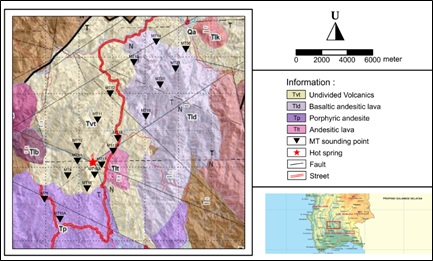Identification of Geothermal System In “Diana” Area, Indonesia Based On Magnetotelluric Data Modelling
DOI:
https://doi.org/10.25299/jgeet.2022.7.1.7448Keywords:
Geothermal System, Inversion, Magnetotelluric, ResistivityAbstract
These days, the number of geothermal explorations is being increased to obtain a greater new potential of geothermal energy. One of the methods that is often used is magnetotelluric (MT). By MT, the components of a geothermal system can be delineated based on the resistivity values. This research’s main purpose is MT data modelling in 1 D and 2 D to delineate the geothermal system in the research area. There are 18 point of soundings, with a distance of about 1 – 3 km for each point. Bostick Transformation is used in 1 D modelling while Non-Linear Conjugate Gradient inversion is used as 2 D modelling with L – curve analysis as a method to obtain an optimal value of regularization parameter. Based on the analysis of 1 and 2 D models, the caprock zone was identified with a resistivity value of < 50 Ωm at a depth of 500 m with a thickness of about 250 m. The reservoir zone was identified with a resistivity value range of (50 – 100) Ωm located at a depth of 1000 with a thickness of about 500 m. Also, fault structures have been identified at the center of the research area. The regularization parameter used for the 2 D modelling is 5, which has obtained RMS values of 2.25% and 2.21% for each line.
Downloads
References
Flóvenz, Ó.G., Spangenberg, E., Kulenkampff, J., Árnason, K., Karlsdóttir, R. dan Huenges E., 2005. The role of electrical conduction in geothermal exploration. Proceedings World Geothermal Congress 2005, Antalya, Turkey.
Geosystem SRL. 2008. A Guide to using WinGLink. Milan: Geosystem SRL.
Grandis, Hendra. 2009. Pengantar Pemodelan Inversi Geofisika. HAGI, Jakarta.
Hansen, P. C., 1992. Analysis of discrete ill – posed problems by means of the L – curve, SIAM Rev, 34, 561 – 580.
Jones, A., G. 1983. On the Equivalence of the “Niblett” and “Bostick” Transformations in the Magnetotelluric Method. J Geophys, 53, 72 – 73.
Katili, J. A. 1975. Volcanism and plate tectonics in the Indonesian Island Arcs. Tectonophysics. 26, 165 – 188.
Kauffman, A. A., dan Keller, G., V. 1981. The Magnetotelluric Sounding Method. Elsevier Scientific Publishing Company.
Kholid, M. dan Marpaung, H. 2011. Survei Magnetotellurik Daerah Panas Bumi Lili-Sepporaki, Kabupaten Polewali Mandar, Provinsi Sulawesi Barat. Prosiding Hasil Kegiatan Pusat Sumber Daya Geologi.
Kristmannsdóttir, H., 1979. Alteration of basaltic rocks by hydrothermal activity at 100 - 300°C. Developments in Sedimentology, 27, 359 – 367.
Llera, F., J., Sato, M., Nakatsuka, K. dan Yokoyama, H. 1990. Temperature dependence of the electrical resistivity of water saturated rocks. Geophysics, 56, 576 – 585.
Lichoro, C. M. 2015. Comparison of 1-D, 2-D and 3-D Inversion Approaches of Interpreting Electromagnetic Data of Silali Geothermal Area. Australia: Proceedings World Geothermal Congress 2015.
Mwakirani, Raymond. 2012. Magnetotelluric (MT) Data Processing. United Nations University Geothermal Training Programme.
Pedersen, J., dan Hermance, J., F. 1986. Least squares inversion of one – dimensional magnetotelluric data: An assessment of procedures employed by Brown University. Surveys in Geophysics, 8 (2), 187 – 231.
Peri, V. P., dll. 2014. Shallow Geophysical Evaluation of the Transition Zone between the Guarani and Yrenda – Toba – Tarijeno Aquifer Systems (Argentine Gran Chaco). Revista Mexicana de Ciencias Geologicas, 31 (1), 76 – 92.
Postendorfer, G. 1975. Principles of Magnetotelluric and Prospecting. Geopublication Associates, 1 (5).
Purnomo, 2014. Ketahanan Energi Nasional 2014. Jakarta: Dewan Energi Nasional.
Rodi, W., dan Mackie, R., L. 2001. Nonlinear Conjugate Gradients Algorithm for 2-D Magnetotelluric Inversion. Geophysics, 66 (1), 174 – 187.
Rodriguez, O. D., Enriquez, O. C., Fucugauchi, J. U., dan Arzate, J. A. 2001. Occam and Bostick 1-D Inversion of Magnetotelluric Soundings in the Chicxulub Impact Crater, Yucatán, Mexico. Geofisica Internacional, 40 (4), 271 – 283.
Rogers, Stuart. 2005. Data Processing User Guide. Canada: Phoenix Geophysics Limited.
Rogers, Stuart. 2010. V5 System 2000 MTU / MTU-A User Guide. Canada: Phoenix Geophysics Limited.
Simpson, F. dan Bahr, K. 2005. Practical Magnetotellurics. Cambridge: Cambridge University Press.
Sofyan, Y., Ehara, S. dan Daud, Y. 2009. Decades of Indonesian Geothermal Energy Growth. J. Geotherm, 31(3), 167 – 176.
Unsworth, Martyn. 2009. Introduction to Electromagnetic exploration methods. Geophysics 223, University of Alberta.
Unsworth, Martyn. 2016. Theory of electromagnetic (EM) field propagation in the Earth. Geophysics 424, University of Alberta.
Ussher, G., Harvey, C., Johnstone, R. dan Anderson E. 2000. Understanding The Resistivities Observed in Geothermal Systems. Proceedings World Geothermal Congress 2000, 1915 – 1920.
Vozoff, Keeva. 1991. The Magnetotelluric Method in Nabighian, M.N., Electromagnetic Methods in Applied Geophysics, Tulsa, Okla., Society of Exploration Geophysics, 37, pt.B, p.641-711.
Vozoff, Keeva. 1980. Electromagnetic Methods in Applied Geophysics. Australia: D Reidel Publishing Company, Geophysical Surveys 4, 9 – 29.
Ward, S., H. dan Hohmann, G., W. 1988. Electromagnetic Theory for Geophysical Applications. M. N. Nabighian, Ed., Electromagnetic Methods, Theory and Practice, Society of Exploration Geophysicist, 1, 131 – 311.
Woldesemayet, B. 2013. Processing and 1D Inversion of Magnetotelluric Data from Dubti Area in Tendaho Geothermal Field, Ethiopia. United Nations University Geothermal Training Programme, 933 – 955.

Downloads
Published
Issue
Section
License
Copyright @2019. This is an open-access article distributed under the terms of the Creative Commons Attribution-ShareAlike 4.0 International License which permits unrestricted use, distribution, and reproduction in any medium. Copyrights of all materials published in JGEET are freely available without charge to users or / institution. Users are allowed to read, download, copy, distribute, search, or link to full-text articles in this journal without asking by giving appropriate credit, provide a link to the license, and indicate if changes were made. All of the remix, transform, or build upon the material must distribute the contributions under the same license as the original.










